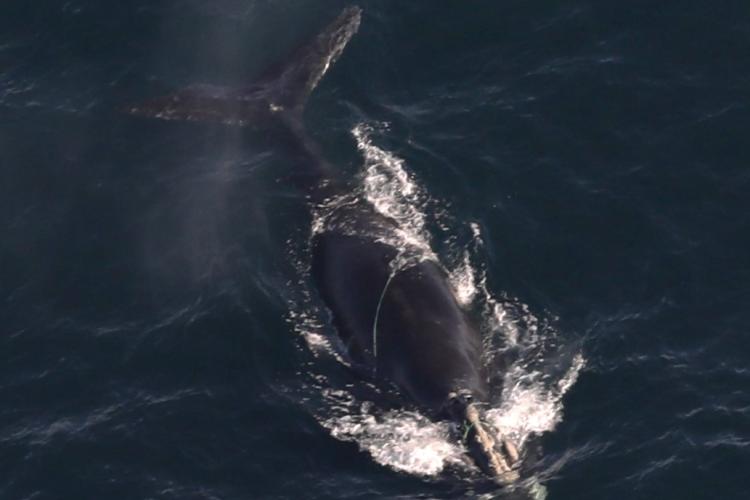July 10, 2025
Eyes in the Sky: How Satellites Could Help Save North Atlantic Right Whales
One of the largest animals on Earth, the critically endangered North Atlantic right whale, survives on some of the smallest creatures in the ocean — tiny “ocean bugs” called copepods, each about the size of a grain of rice. But not just any copepods will do. These whales are especially fond of Calanus finmarchicus, a fatty, energy-rich species that packs a powerful caloric punch.
But for these giant whales to get enough to eat, they have to find super dense swarms of these copepods, and ocean conditions have to be just right for that to happen. If the quantity or quality of copepods isn’t good, the whales may have to keep searching, hoping to find a good feeding spot where they can stay and gorge on their favorite fatty food. It can be like finding a needle in a haystack… only the haystack is the vast Atlantic Ocean.

A Delicate Balance
To create a rich buffet of copepods, the ocean has to hit just the right recipe: sunlight, salinity, temperature, and nutrients all play a role. But as the climate changes — melting ice, shifting ocean temperatures, and changes in salinity — this balance is being thrown off. That could mean fewer copepods, and fewer feeding opportunities for right whales.
A Dangerous Shift
In 2010, warming waters pushed copepods into new areas — and the whales followed. That meant right whales ended up in unfamiliar territory, outside the areas protected from ship strikes and fishing gear. The result? More injuries. More entanglements. More deaths. In 2017, the National Oceanic and Atmospheric Administration (NOAA) declared an Unusual Mortality Event for North Atlantic right whales. That declaration, which means an event where a large number of marine mammals are found dead or dying, remains in place today.
Since 2017, at least 80 North Atlantic right whales have died or been seriously injured. That’s devastating for a species with only about 370 individuals left.

Credit: NOAA Fisheries, taken under NOAA permit #27066
Eyes in the Sky
To protect these whales, we need to know where they’re going before they get there. That’s where NASA — and some high-tech help from space — comes in. Copepods that North Atlantic right whales eat have a red pigment that can show up in satellite images. With the help of NASA satellites, scientists are using this red pigment to estimate where dense copepod swarms might be and predict where whales might soon follow. And additional satellites launched earlier this year are expected to offer an even clearer picture of where whales might go next.

Credit: NASA Earth Observatory image by Wanmei Liang, using data from Shunmugapandi, R., et al. (2025)
What This Means for Whales — and People
This breakthrough could allow scientists to predict right whale feeding hotspots before the whales arrive, giving federal agencies like NOAA, boaters, and fishers critical time to take action. That means smarter protections, fewer entanglements and boat strikes, and a better chance at survival for one of the most endangered whales on the planet. It also helps protect the people who share the ocean with them. If we can pinpoint where these whales will be, fishers outside of that area can stay on the water longer and avoid catastrophic boat strikes that are dangerous for boaters and whales. In short, detecting this whale’s prey is how satellites could help save the North Atlantic right whale.
At Oceana, we’re campaigning for the United States’ and Canadian governments to strengthen protections for these gentle giants and ensure their future. Supporting government agencies like NOAA and NASA and their work to explore innovative technology like this is critically important and a major asset to protect North Atlantic right whales and give these whales a chance to survive.
Learn more about our campaign or sign our petition calling for stronger action to protect these critically endangered whales today.



